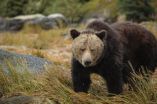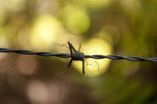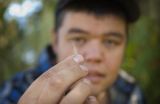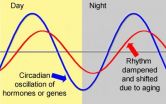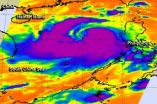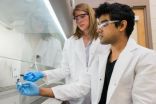(Press-News.org) A novel, First Nations-led research collaboration has revealed a previously undocumented grizzly bear aggregation in coastal British Columbia, one of the most southerly aggregations of salmon-feeding grizzlies in North America. Using non-invasive DNA analysis, the authors describe a grizzly bear "highway," identifying nearly 60 individual bears, many who travelled hundreds of miles from surrounding areas to feed on autumn-spawning salmon in the Koeye River. The research was guided by the customary law and cultural practices of the Heiltsuk First Nation and recently published in the journal Ecology and Society.
Conducted over three years, the study also provides potential early evidence of a declining bear population in the area and links this to the decreasing availability of salmon. The project demonstrates a model for resource management by indigenous people, in which research is embedded within a socially and culturally appropriate framework.
"What's really novel here is the set of relationships, and deep cultural histories, that guided applied conservation science," said Chris Filardi, director of Pacific programs at the American Museum of Natural History's Center for Biodiversity and Conservation and an author on the paper. "In this collaborative setting, results are directly relevant to tribal leadership impacting conservation in ways that elude most scientific studies."
The study was centered in the Koeye River Conservancy, one of numerous protected areas designated by the Heiltsuk First Nation in the Great Bear Rainforest of British Columbia in 2009. The Heiltsuk people settled in this area more than 9,000 years ago and are now reasserting their rights as guardians of the Koeye River. To realize this renewal, they established the Qqs (Eyes) Projects Society, a Heiltsuk-driven nonprofit that builds capacity for research, monitoring, and tribal governance of high-value stewardship areas. In 2006, the Heiltsuk people partnered with the Museum and The Nature Conservancy to implement a grizzly bear survey project with a unique dimension: from the outset, the study was designed to uphold the Heiltsuk Nation's Gvi'ilas, or customary law, a set of guiding principles that frame a worldview focused on core values.
"What appealed to us was the opportunity to root science in strong cultural stewardship frameworks," said Qqs' William Housty. "We articulate specific Heiltsuk laws and customs related to respect and reciprocity and match them with scientific tools and knowledge to put those principles in action."
During the survey, grizzly bear hair was collected as the animals walked by scented wire snares set up in the area during salmon-spawning season. As part of the non-invasive aspect of the work, the "baits" did not provide rewards to the bears visiting the snares.
At the same time, the team calculated the accessibility of salmon to bears with an index based on the number of salmon that return to the Koeye each year; water flow; and water visibility. Over the three-year survey, they found a decreasing population of bears in the Koeye, likely tied to declining salmon accessibility.
"This study shows that protected areas are not enough. We knew that bears are wide-ranging, but this study shows how vulnerable they are to a variety of threats," said Richard Jeo, a staff scientist for The Nature Conservancy. "Scientific insight can help guide management but the fate of these bears and the rainforest where they live is still largely in the hands of a few First Nations."
"We want to practice land and resource management with strong information empowering our decision makers," Housty said. "Whether it's regulating activities like forestry and tourism or indigenous-led advocacy to end trophy hunting for bears, ensuring that we ourselves are leading the best available science is a critical part of asserting our sovereignty and stewardship responsibility."
The next step for the group is to expand survey work to include a broader sampling of culturally significant salmon streams, improve linkages to salmon monitoring, and directly involve Heiltsuk families and their histories with places they share with bears.
"What is most important is Heiltsuk-driven science across the range of areas used by bears and people," Filardi said. "Knowledge about the interwoven ecologies of bears, salmon, and people can guide actions unavailable in places farther south where bears and salmon have vanished, or across broader society, where we have not yet come to value bears and salmon as integral to our physical and spiritual lives."
INFORMATION:
Funding for the collaboration was provided by The Nature Conservancy, Wilburforce Foundation, Disney Worldwide Conservation Foundation, and the American Museum of Natural History.
Study led by indigenous people uncovers grizzly bear 'highway'
Unique research collaboration guided by first nations customary law reveals major salmon-feeding grizzly aggregation in British Columbia
2014-07-17
ELSE PRESS RELEASES FROM THIS DATE:
Lipoic acid helps restore, synchronize the 'biological clock'
2014-07-17
CORVALLIS, Ore. – Researchers have discovered a possible explanation for the surprisingly large range of biological effects that are linked to a micronutrient called lipoic acid: It appears to reset and synchronize circadian rhythms, or the "biological clock" found in most life forms.
The ability of lipoic acid to help restore a more normal circadian rhythm to aging animals could explain its apparent value in so many important biological functions, ranging from stress resistance to cardiac function, hormonal balance, muscle performance, glucose metabolism and the aging ...
How the brain stabilizes its connections in order to learn better
2014-07-17
Throughout our lives, our brains adapt to what we learn and memorise. The brain is indeed made up of complex networks of neurons and synapses that are constantly re-configured. However, in order for learning to leave a trace, connections must be stabilized. A team at the University of Geneva (UNIGE) discovered a new cellular mechanism involved in the long-term stabilization of neuron connections, in which non-neuronal cells, called astrocytes, play a role unidentified until now. These results, published in Current Biology, will lead to a better understanding of neurodegenerative ...
NASA's Aqua satellite sees birth of Tropical Depression 10W
2014-07-17
The tenth tropical depression of the Northwestern Pacific Ocean was born as NASA's Aqua satellite passed overhead.
NASA's Aqua satellite passed over Tropical Depression 10W on July 17, as it came together northwest of the island of Yap. As Aqua passed overhead the Atmospheric Infrared Sounder (AIRS) instrument aboard captured infrared data that showed powerful thunderstorms developed around the storm's center. When AIRS gathered the data on the cloud tops, the temperatures were already as cold as -63F/-52C, indicating strong uplift has pushed them to the top of the troposphere.
At ...
NASA's TRMM satellite adds up Typhoon Rammasun's Philippines deluge
2014-07-17
Typhoon Rammasun dropped large amounts of rainfall over the Philippines, and the TRMM satellite was used to measure it from space. Rammasun is now making its way toward Hainan Island, China.
NASA and the Japanese Aerospace Exploration Agency partner on the Tropical Rainfall Measuring Mission or TRMM satellite. As TRMM orbits the Earth it has the ability to calculate rainfall occurring in storms and a rainfall analysis using TRMM and other data helps scientists calculate total rainfall.
A preliminary analysis of rainfall during the period when typhoon Rammasun was moving ...
Scientists track gene activity when honey bees do and don't eat honey
2014-07-17
CHAMPAIGN, Ill. — Many beekeepers feed their honey bees sucrose or high-fructose corn syrup when times are lean inside the hive. This practice has come under scrutiny, however, in response to colony collapse disorder, the massive -- and as yet not fully explained -- annual die-off of honey bees in the U.S. and Europe. Some suspect that inadequate nutrition plays a role in honey bee declines.
In a new study, described in Scientific Reports, researchers took a broad look at changes in gene activity in response to diet in the Western honey bee (Apis mellifera), and found ...
Measuring nurture: Study shows how 'good mothering' hardwires infant brain
2014-07-17
By carefully watching nearly a hundred hours of video showing mother rats protecting, warming, and feeding their young pups, and then matching up what they saw to real-time electrical readings from the pups' brains, researchers at NYU Langone Medical Center have found that the mother's presence and social interactions — her nurturing role — directly molds the early neural activity and growth of her offsprings' brain.
Reporting in the July 21 edition of the journal Current Biology, the NYU Langone team showed that the mother's presence in the nest regulated and controlled ...
Scripps Florida scientists identify gene that plays a surprising role in combating aging
2014-07-17
JUPITER, FL, July 17, 2014 – It is something of an eternal question: Can we slow or even reverse the aging process? Even though genetic manipulations can, in fact, alter some cellular dynamics, little is known about the mechanisms of the aging process in living organisms.
Now scientists from the Florida campus of The Scripps Research Institute (TSRI) have found in animal models that a single gene plays a surprising role in aging that can be detected early on in development, a discovery that could point toward the possibility of one day using therapeutics, even some commonly ...
Crohn's disease research
2014-07-17
University of Delaware researchers have identified a protein, hiding in plain sight, that acts like a bodyguard to help protect and stabilize another key protein, that when unstable, is involved in Crohn's disease. The fundamental research points to a possible pathway for developing an effective therapy for the inflammatory bowel disease.
The research, by Catherine Leimkuhler Grimes, assistant professor of chemistry and biochemistry at UD, and Vishnu Mohanan, doctoral student in biological sciences, is published in the July 4 issue of the Journal of Biological Chemistry. ...
Carnegie Mellon combines hundreds of videos to reconstruct 3D motion without markers
2014-07-17
PITTSBURGH—Carnegie Mellon University researchers have developed techniques for combining the views of 480 video cameras mounted in a two-story geodesic dome to perform large-scale 3D motion reconstruction, including volleyball games, the swirl of air currents and even a cascade of confetti.
Though the research was performed in a specialized, heavily instrumented video laboratory, Yaser Sheikh, an assistant research professor of robotics who led the research team, said the techniques might eventually be applied to large-scale reconstructions of sporting events or performances ...
Incidence of stroke in the elderly has dropped by 40 percent over the last 20 years
2014-07-17
Philadelphia, PA, July 17, 2014 – A new analysis of data from 1988-2008 has revealed a 40% decrease in the incidence of stroke in Medicare patients 65 years of age and older. This decline is greater than anticipated considering this population's risk factors for stroke, and applies to both ischemic and hemorrhagic strokes. Investigators also found death resulting from stroke declined during the same period. Their findings are published in the July issue of The American Journal of Medicine.
Preventable but deadly, stroke is the fourth leading cause of mortality in the ...
LAST 30 PRESS RELEASES:
Alexander Khalessi, MD, MBA, appointed Chief Innovation Officer
Optical chip pioneers physical-layer public-key encryption with partial coherence
How your brain understands language may be more like AI than we ever imagined
Missed signals: Virginia’s septic strategies overlook critical timing, study warns
Delayed toxicities after CAR T cell therapy for multiple myeloma are connected and potentially preventable
Scientists find cellular key to helping plants survive in saltwater
Medical cannabis program reduces opioid use
Immunotherapy works for sepsis thanks to smart patient selection
Cardiovascular events 1 year after RSV infection in adults
US medical prices and health insurance premiums, 1999-2024
Medical cannabis and opioid receipt among adults with chronic pain
Multichannel 3D-printed bioactive scaffold combined with siRNA delivery for spinal cord injury recovery
Triaptosis—an emerging paradigm in cancer therapeutics
A new paradigm in spectroscopic sensing: The revolutionary leap of SERS-optical waveguide integration and ai-enabled ultra-sensitive detection
Sweet tooth: How blood sugar migration in diabetes affects cavity development
Lowest suicide rate is in December but some in media still promote holiday-suicide myth
Record-breaking cosmic explosion challenges astronomers’ understanding of gamma-ray bursts
Excessive heat harms young children’s development, study suggests
Quanta Books to publish popular math and physics titles by Terence Tao and David Tong
Philanthropic partnerships fund next-generation instruments for mid-sized telescopes
AI offers ‘roadmap’ to plant genetics
Myosin XI-1: A key molecular target for salt-tolerant crops
Pusan National University study highlights the health hazards of ultrafine particles from small home appliances with electric heating coils and brushed DC motors
Global first: New Indigenous-led research initiative to revitalize legal orders
Transforming acoustic waves with a chip
When climate risk hits home, people listen: Study reveals key to engagement with disaster preparedness messaging
Major breakthrough against diabetes thanks to a microbial molecule that disarms inflammation
Silicon chips on the brain: Researchers announce a new generation of brain-computer interface
Getting rest is the best
Towards sustainable organic synthesis – Mechanochemistry replaces lithium with sodium in organic reactions
[Press-News.org] Study led by indigenous people uncovers grizzly bear 'highway'Unique research collaboration guided by first nations customary law reveals major salmon-feeding grizzly aggregation in British Columbia
